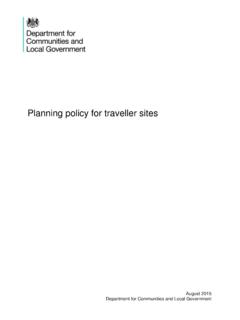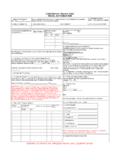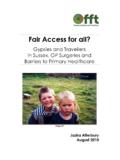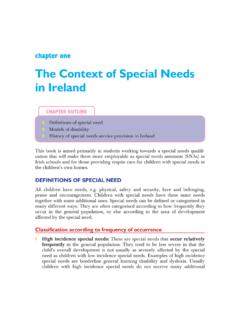Transcription of Supporting children’s transitions across the Early Years ...
1 Supporting children s transitions across the Early Years Foundation stage transitions Matter 1. The Key PersonThe Key PersonThe Early Years Foundation stage challenges us to ensure each child in a nursery setting or Reception is allocated a Key a Key Person is understood to be a person to co-ordinateobservations and record-keeping for the child. Whilst an administrative system like this may be an important part of the way you work in nursery or Reception, it is not the same as a Key Person system. A Key Person system is not principally about administration and Key Person is: a named member of staff who has more contact than others with the child someone to build relationship with the child and parents someone who helps the child become familiar with the provision someone who meets children s individual needs and care needs ( dressing, toileting etc) someone who responds sensitively to children s feelings, ideas and behaviour the person who acts as a point of contact with parents.
2 (Guidance: the Key Person in Reception classes and small nursery settings by Julian Grenier, Peter Elfer, Julia Manning Morton, Dilys Wilson and Katie Dearnley)What is a Key Person?Provides a secure base for their key children to support their exploration away from themHas more contact than others with the child and is a point of contact with parentsProvides eye contact, body language and sensitive voice to let children know they are interestedSettles new children in gradually, helps them become familiar with the setting and supports their arrival and departure each dayDevelops secure trusting relationships with children and parentsResponds sensitively to children s feelings, ideas and behaviourIs physically and emotionally available to their key childrenMeet s children s care, learning and development needsA Key Person2.
3 Guide to Support transitions for Under 2 sA Useful Guide to Support transitions for Under Two sIt is important to remember that any transition must be planned and thoughtful transitions often have a smoother more beneficial outcome for the baby/toddler and their Parents/Carers. Remember transitions are very individual, what has worked for one baby/toddler may not be as successful for another. The Key Person will play an essential role in any transition (see The Key Person card). A baby/toddler passes through many stages of development and at some point learns that a world exists outside of what it can see; Babies and toddlers have little understanding of time. A transition into a setting is a process over a few weeks but this may be longer or shorter depending on the baby/toddlers individual needs.
4 1. A baby/toddler will initially need their primary attachment figure with them for the visits in order for them to feel comfortable enough to explore their environment. It is important to remember that the Parents/Carers will often find this an incredibly stressful time in their lives; they may feel abandoned and unloved by their child as their child begins to form a close bond with another adult. We as practitioners must show extreme sensitivity to Parents/Carers in how they personally manage this The baby/toddler will also need a caring and sensitive Key Person to be assigned to them from the outset. The Key Person will need to become a familiar face to the child and be there to support the Parents/Carers as much as they support the Have a well thought out settling in policy which is clearly understood by Parents/Carers highlighting the need for a settling in period.
5 This should support parents to understand why a settling in period is vital. The Key Person should be available and approachable to the Make a book up with photos of the nursery/Reception; include areas such as the toilet, the dinner hall, the playground, key toys and resources. Include a book all about the Key Person that can be shared and left with the child at the home visit before they start at the Before the child starts at your setting find out from Parents/Carers important information such as - What is the child s routine? Do they have any patterns to their behaviour? How do they like to be soothed and comforted? How do they show their distress? Do they have a favourite toy? What foods do they like/ dislike? Do they have any separation rituals that you need to respect?
6 4. Before a child starts include special people in their lives on your family wall or in a small book so that they feel a sense of belonging from the start. Provide cubbies in your setting where a child can place personal objects that are meaningful to them. If the child has a comforter respect this and allow them the access they need, when they need it. 3. transitions Out of SchoolTransitions in Out of School ProvisionPractitioners in out of school provision have the privilege of Supporting children through a range of transitions , not least the transition into the setting. This is likely to come in four ways: From a pre-school into a Reception class and an out of school provision in one move for some 4 year olds From a Reception class once they have started school From school at any age From a childminder at any stageOther transitions may include the transition from an infant to a junior school and from a primary/junior school to secondary school.
7 transitions are likely to include a walk or journey from the school to the reasons that these transitions will be taking place may include changes at home, including the main parent/carer going out to work for the first time. Changes both at home and at school can be very unsettling for children and it is vital that practitioners use all their skills, strategies and expertise to support children through these. There is a lot of good practice going on in settings to support transitions in out of school provision. This includes: The Key Person (see The Key Person card) making home visits (see photocopy materials), particularly for children in the Early Years Foundation stage (EYFS) age range Having an open afternoon/morning so that all new children can attend with parents/carers and see how the after school club/breakfast club/holiday club works Having an all about me or my favourites sheet for the children to complete as part of the registration process.
8 This enables the children to tell you things about themselves before they even arrive in the setting, giving the children a voice in the setting at the outset Inviting parents and children to attend at least one session together, free of charge, so that the child has an opportunity to experience the opportunities in the provision with the security of knowing that a parent/carer and Key Person are there to support them. This enables parents to understand the routine of the setting and supports the building of positive relationships Some free taster sessions for children to attend on their own, starting with a short one and gradually building up to a whole session to develop the child s security in the setting A buddy for the child when they start, who can be there to help the child in their first few weeks, and be a point of contact who is not an adult.
9 Being inclusive by working in partnership with the parents, school and any other agencies to support the child through the transition period, including the trip from school to the setting. For children in the EYFS age range this must include some way of sharing information between the Reception class teacher, the setting and the parents/carers a contact book. It may also include asking the school to share their planning so that the setting is aware of what the child is doing at school. If the child is buzzing with this when they come out of school the setting is prepared and can develop the interest further Using the information gained from parents and children over the initial transition period to include activities and resources in the planning that will support new children to feel more at home, ensuring that you give both the parents and the child a voice in the setting Creating a positive environment (staff, support, resources, environment) to support the emotional needs of the children and to ensure that each child is acknowledged, individually affirmed and secure in the setting.
10 This might include having photos of the children in the setting displayed so that you can add photos of children new to the setting, ensuring that they feel welcomed, valued and included Regular meetings with the parent/carer, particularly over the first few weeks, to ensure that the child is settling well and that everyone is working together effectively to meet the needs of the childSimilarly transitions out of the setting are important. Some ways in which practitioners can support this are: Inviting back children who have already made the transition to spend some time with the children about to go through the transition Working with the new setting to support transition Listening. This is often the most important part of playwork and it is certainly vital in Supporting children through transitions4.






